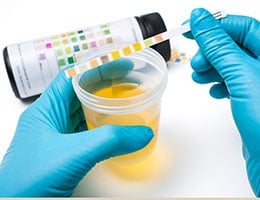 Every day in the practice of medicine, hundreds of thousands of urine samples are tested. The maxim that states “all females between ages 10 and 60 with abdominal pain must have a urine pregnancy test” has been ingrained into our cerebral cortexes. Since the times of ancient medicine, the urinalysis has been used to screen for a host of diseases. The urinalysis is a vital tool in evaluating patients. However, as helpful as it is, it has also led many clinicians down the wrong path towards chaos. Two different cognitive medical errors come to mind when interpreting the urinalysis.
Every day in the practice of medicine, hundreds of thousands of urine samples are tested. The maxim that states “all females between ages 10 and 60 with abdominal pain must have a urine pregnancy test” has been ingrained into our cerebral cortexes. Since the times of ancient medicine, the urinalysis has been used to screen for a host of diseases. The urinalysis is a vital tool in evaluating patients. However, as helpful as it is, it has also led many clinicians down the wrong path towards chaos. Two different cognitive medical errors come to mind when interpreting the urinalysis.
- Sutton’s slip: the error of going for the obvious and missing other possibilities
- Search “Satisficing”: calling off the search when one thing has been found and missing something else
We often see the urinalysis results even before we see the patient. A diagnosis is made and the discharge paperwork is completed as we anticipate encountering a simple UTI. Although ultimately the conclusion may be correct, the opportunity to make an important diagnosis may be lost. Errors in the interpretation of urinalysis results are common and can be catastrophic. Following is a review of the urinalysis and possible pitfalls.
Beware of Contamination
A contaminated urine specimen can give a large amount of false data on a dipstick test. Greater than five epithelial cells on microscopic evaluation is likely a sign of contamination.
Specific Gravity
The specific gravity should usually be between 1.002 and 1.030. A high specific gravity (>1.035) could be a sign of contamination. A low specific gravity (<1.005) could result in a false-negative pregnancy test.
Protein
Protein in the urine may be a sign of pyelonephritis or it could be due to dehydration or starvation. However, this is a common finding in renal insufficiency/failure associated with malignant hypertension or diabetes. It is worth checking the renal function in a patient with no known renal disease who has large proteinuria.
Glucose
Glucose typically spills into the urine above a serum level of 160 - 180 mg/dl. This is common in patients with known diabetes. However, if the patient does not have a history of diabetes, checking a chemistry panel is likely warranted. This is also a quick check to rule out DKA in the otherwise healthy patient with presumed gastroenteritis.
Ketones
Ketonuria is commonly found with DKA, starvation/fasting, and hyperemesis gravidarum. Positive urine ketones and glucosuria should be a warning sign of DKA and should not be overlooked.
Nitrite
 This is a very specific test for UTI. However, due to rapid transit of urine in children who are not potty-trained, it is not likely to be present in children with pyelonephritis. This test in patients on medications like phenazopyridine (AZO, Pyridium) or those with gross hematuria whose dipstick may be falsely positive due to discolored urine should be viewed with skepticism.
This is a very specific test for UTI. However, due to rapid transit of urine in children who are not potty-trained, it is not likely to be present in children with pyelonephritis. This test in patients on medications like phenazopyridine (AZO, Pyridium) or those with gross hematuria whose dipstick may be falsely positive due to discolored urine should be viewed with skepticism.
WBCs and Leukocyte Esterase
When present, these suggest a UTI. Remember that the ureter and bladder are near the appendix and other structures, and that inflammation of these nearby structures (appendix, ovary, fallopian tube, colon) can produce pyuria – WBCs in the urine. False positive urine results have been seen with:
- A contaminated specimen
- Gynecologic infection (PID, cervicitis, TOA)
- Neoplasm
- Appendicitis
- Some references would also include pancreatitis and gastroenteritis
- Postpartum endometritis & sepsis
Blood
May be present in several processes, including ureterolithiasis, rhabdomyolysis, aortic dissection, and abdominal aortic aneurysm.
We have seen medical errors and malpractice suits involving a missed or delayed diagnosis of appendicitis because the provider wrongly concluded that WBCs in the urinalysis represented a UTI. Likewise, a few RBCs in the urinalysis has led to the missed diagnosis of AAA. Do not fall into the trap of seeing a “dirty urine” and automatically concluding the patient has “only a UTI” or a “kidney stone.” Make sure the clinical presentation and history are consistent. The urinalysis is a great tool, but it should not supersede sound clinical evaluation and judgment.


